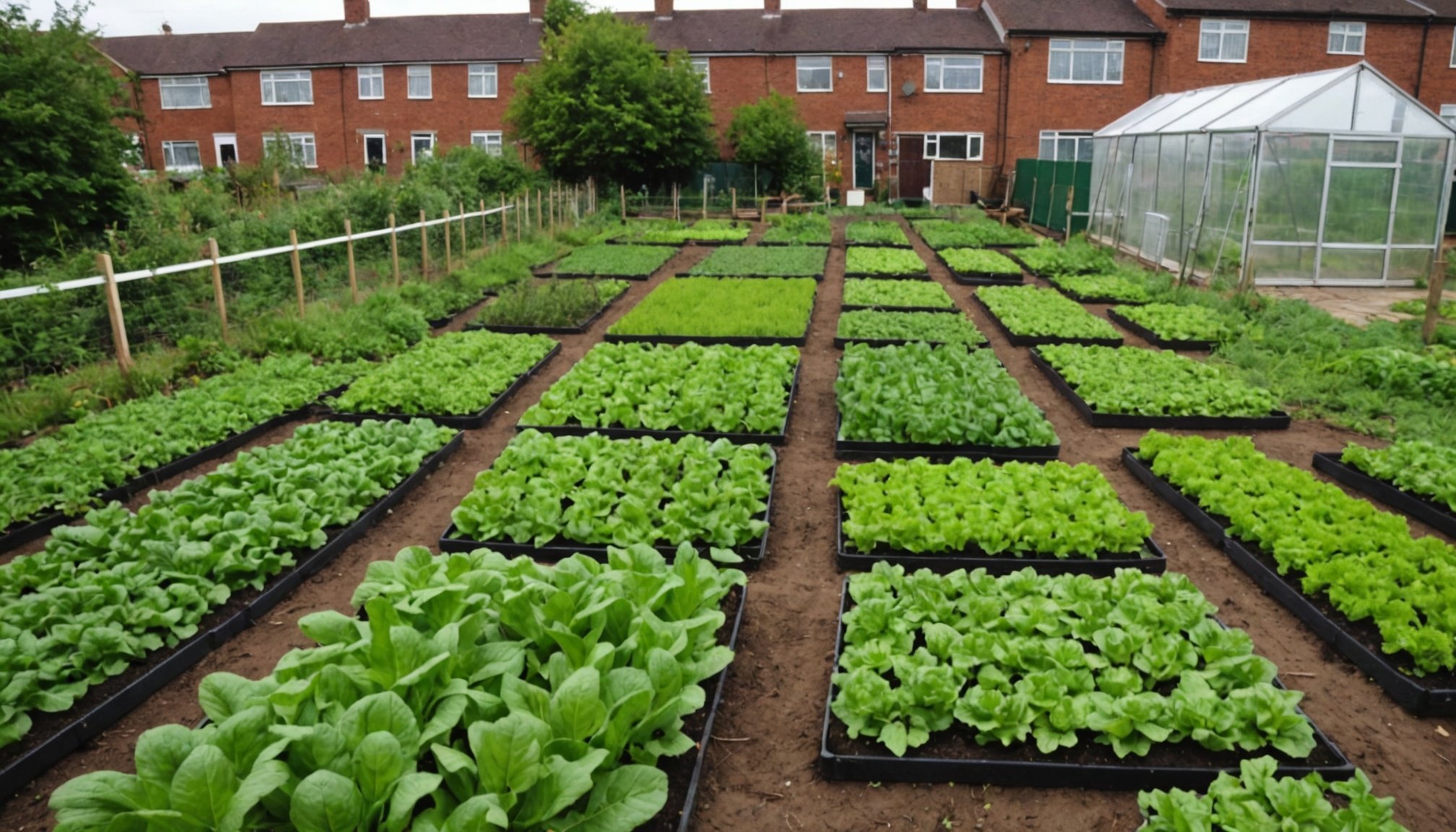Revitalizing Urban Landscapes: The UK’s Urban Farming Revolution and Its Impact on Local Communities in Food Deserts
The Rise of Urban Agriculture in the UK
Urban agriculture, the practice of cultivating, processing, and distributing food in urban areas, has been gaining momentum in the UK as a solution to various societal and environmental challenges. This movement is not new, but its modern iteration is driven by a mix of economic, social, and environmental motivations.
In the UK, urban farming has evolved from small-scale community gardens to larger, more organized urban farms. These initiatives are often spearheaded by community groups, social movements, and local authorities aiming to address food security, nutrition, and economic development. For instance, the concept of “transition towns” has been adopted in several UK cities, where urban agriculture is integrated into local town planning to promote sustainable urban development[1].
Additional reading : Key approaches for uk citizens to combat upcoming water scarcity challenges
Addressing Food Deserts Through Urban Farming
Food deserts, areas where access to fresh, healthy food is limited, are a significant issue in many urban communities. Urban farming offers a viable solution by bringing fresh produce directly to these areas. Here are some ways urban farming is making a difference:
- Community Engagement: Urban farms often involve the local community in the growing, harvesting, and distribution of food. This not only provides fresh produce but also fosters community relationships and a sense of ownership among residents[1].
- Food Security: By growing food locally, urban farms reduce the reliance on long supply chains, thereby improving food security. For example, a study in Cleveland showed that urban agriculture could meet up to 100% of the city’s fresh produce needs, preventing significant economic leakage[1].
- Economic Benefits: Urban farming can generate income for local residents, either through the sale of produce or by providing employment opportunities. This economic activity can be particularly beneficial in areas with high rates of economic insecurity.
Types of Urban Farms and Gardens
Urban farms and gardens in the UK come in various forms, each with its unique characteristics and benefits.
Also to discover : Revolutionizing uk weather predictions: unleashing deep learning for superior forecast accuracy
City Farms and Community Gardens
City farms are agricultural plots within urban areas where people work with animals and plants to produce food. These are often community-run and aim to improve community relationships and raise awareness about agriculture among urban residents. They can range from small plots in private yards to larger farms spanning several acres[1].
Vertical Farming
Vertical farming is a modern approach to urban agriculture, involving the cultivation of crops in vertically stacked layers or inclined surfaces within controlled indoor environments. This method maximizes space utilization and allows for year-round cultivation, making it ideal for densely populated urban areas. Vertical farms use advanced techniques such as hydroponics or aeroponics, ensuring higher crop yields per square foot compared to traditional farming methods[1].
Policy and Planning Support
The success of urban farming initiatives in the UK is often dependent on policy and planning support from local authorities.
- Land Use Planning: Cities are beginning to incorporate urban agriculture into their land use planning. For example, vacant lots that were once seen as blighted areas are now being transformed into productive urban farms and gardens[1].
- Financial Support: Government funding and private enterprises play a crucial role in financing urban agriculture projects. This financial support can help in setting up infrastructure, such as greenhouses and vertical farming facilities, and in providing resources for community-led initiatives[1].
- Educational Programs: Organizations like the Country Trust are working to integrate food and farming education into school curricula, ensuring that future generations understand the importance of local food production and sustainable agriculture practices[4].
Impact on Local Communities
The impact of urban farming on local communities is multifaceted and far-reaching.
Food Justice and Sovereignty
Urban farming contributes to food justice by ensuring that all members of the community have access to fresh, nutritious food. This is particularly important in food deserts where healthy food options are scarce. By growing food locally, communities can achieve a level of food sovereignty, reducing their dependence on external food systems[1].
Environmental Benefits
Urban farming helps in mitigating environmental issues such as climate change and soil degradation. By reducing food miles, urban farms lower greenhouse gas emissions associated with transportation. Additionally, practices like vertical farming and community gardening promote sustainable land use and help in maintaining soil health[1].
Human Values and Community Building
Urban farming projects often serve as community hubs, fostering social connections and a sense of community among residents. These initiatives promote human values such as cooperation, mutual support, and a shared ethos of nature and community holism[1].
Practical Insights and Actionable Advice
For those interested in starting or supporting urban farming initiatives, here are some practical insights and actionable advice:
Starting a Community Garden
- Identify Available Land: Look for vacant lots or underutilized spaces in your community that could be transformed into gardens.
- Engage the Community: Involve local residents in the planning and execution of the garden to ensure it meets community needs and fosters a sense of ownership.
- Seek Funding and Resources: Apply for grants, seek donations, and partner with local organizations to secure the necessary resources for your project.
Supporting Urban Farms
- Buy Local: Purchase produce from local urban farms to support the local economy and ensure the sustainability of these initiatives.
- Volunteer: Many urban farms rely on volunteer labor; contributing your time can help these projects thrive.
- Advocate for Policy Support: Encourage your local authorities to incorporate urban agriculture into their land use planning and policy frameworks.
Examples and Case Studies
New York City’s Rooftop Gardens
New York City is a prime example of how urban agriculture can thrive in densely populated areas. The city’s rooftop gardens and vertical farms are capable of providing a significant portion of the city’s green vegetable yields. This not only improves food security but also reduces food waste and optimizes land use[1].
Country Trust’s Educational Programs
The Country Trust in the UK is an exemplary organization that connects children with farming and nature through hands-on educational programs. By teaching children about the link between diet, human wellbeing, and the health of the planet, they are fostering a new generation of urban farmers and advocates for sustainable food systems[4].
The UK’s urban farming revolution is a testament to the power of community-driven initiatives in transforming urban landscapes and addressing critical issues like food security and environmental sustainability. As Helmy Abouleish, CEO of SEKEM, notes, “If we are to transform our food systems so that the maximum amount of people can eat nutritious food produced in the right ways, we need to work together, share ideas, pool resources and connect as part of a global food movement. Every voice counts.”[2]
By embracing urban agriculture, we can create more resilient, sustainable, and equitable food systems that benefit both people and the planet.
Table: Comparison of Traditional and Urban Farming Methods
| Characteristics | Traditional Farming | Urban Farming |
|---|---|---|
| Location | Rural areas | Urban areas |
| Land Use | Large tracts of land | Small plots, rooftops, vertical spaces |
| Crop Yield | Dependent on season and land quality | Year-round cultivation, higher yields per square foot |
| Water Use | High water consumption | Efficient use through hydroponics and aeroponics |
| Labor | Often mechanized | Community and volunteer-based labor |
| Market Access | Long supply chains | Direct access to local markets |
| Environmental Impact | High greenhouse gas emissions from transportation | Lower emissions, reduced food miles |
| Community Engagement | Limited community involvement | High community engagement and ownership |
Detailed Bullet Point List: Benefits of Urban Farming
- Improved Food Security: Direct access to fresh, nutritious food reduces reliance on external food systems.
- Enhanced Community Relationships: Urban farms serve as community hubs, fostering social connections and a sense of community.
- Economic Benefits: Generates income through the sale of produce and provides employment opportunities.
- Environmental Sustainability: Reduces greenhouse gas emissions, optimizes land use, and promotes sustainable agriculture practices.
- Year-Round Cultivation: Allows for continuous food production regardless of the season.
- Reduced Food Waste: Cuts down on food waste by producing food closer to the point of consumption.
- Educational Opportunities: Provides hands-on learning experiences for children and adults about sustainable food systems.
- Policy and Planning Integration: Encourages sustainable land use planning and policy support from local authorities.
- Food Justice and Sovereignty: Ensures equitable access to healthy food and reduces dependence on external food systems.
- Soil Health Maintenance: Promotes practices that maintain soil health and fertility.





